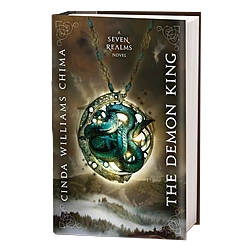The Seven Realms Series is set in a traditional fantasy world of medieval technology, swordplay, castles, and keeps. The action takes place in and around The Seven Realms—seven loosely-related realms once ruled by the Gray Wolf Queens and their wizard consorts or kings. The Seven Realms include the mountainous queendom of the Fells, the kingdom of Tamron, the kingdom of Arden, the southern kingdoms of Bruinswallow, and We’enhaven, the Southern Islands, and the Northern Islands.
The Shivering Fens, a marshy country west of the Fells, have never been totally independent, having been claimed by Tamron and the Fells at different points in history. The Waterwalker people of the Fens consider themselves independent, and relations with the other Realms have been rocky.
At one time, all of the Seven Realms were ruled by the Gray Wolf queens, whose seat of power was located in Fellsmarch, capital city of the Fells. Fellsmarch is located in a high mountain valley or park known as the Vale. The Vale is situated high in the Spirit Mountains, home of the upland clans. Flatlanders to the south claim that both the Vale and the Spirits are infested with sorcery and dangerous magic. The mountain landscape is studded with hot springs and geysers, which moderate the harsh northern winters.
The Gray Wolf queens ruled in a loose alliance with the upland clans. The clans are practitioners of earth magic and masters of materials: they are masters of healing, medicines.
The Line of Queens in the Vale have some magical powers—a kind of intuition and the ability to lead and motivate people. They may also have other powers inherited from a mixture of blood. There is a connection between the Gray Wolf queens and their totem, the Gray Wolf. Often the appearance of a Gray Wolf portends great risk and great opportunity—a turning point in the Line.
A few hundred years later an army of wizards from the Northern Islands invaded the Fells, conquering its capital and enslaving the Gray Wolf queens through the use of powerful sorcery. The wizard conquerors subjugated the rest of the Seven Realms, but maintained the Gray Wolf line. They established a Wizard Council who chose a High Wizard who married the reigning Gray Wolf queen. That way no one wizard family became too powerful. Meanwhile, the clans maintained control of the Spirit Mountains, carrying out a constant guerrilla war against the wizard conquerors.
After years of rule by wizards through the king and the Wizard Council, a dispute arose among wizards regarding who would marry Hanalea ana’Maria, the princess heir to the Gray Wolf Throne and reign as the next king. The Wizard Council chose Kinley Bayar, a Council member, as High Wizard and king.
But Hanalea loved Alger Waterlow. Alger's friend Lucas Fraser was jealous and told The Bayar family about who Hanalea really loved. The Bayar's kidnapped Alger and tortured him almost to death. Alger performed a magical spell that trapped him in his amulet. The Bayar's tried everything to break open the amulet eventually cast an extremly powerful charm at the amulet. The charm backfired!
The world dissolved into chaos—earthquakes, landslides, volcanic eruptions—and the Wizard Council realized they needed help or they would all die. They turned to the clans, who were masters of green magic. Hanalea served as go-between, forging the compromise between the Wizard Council and the clans known as the Nǽming. The Nǽming imposed severe restrictions on wizards and restored the Gray Wolf Line to power as stand-alone queens and established the system by which a wizard was chosen as High Wizard and counselor to the queen. These wizards were magically constrained to use their magic for the benefit of the queen and the queendom.
Wizards were required to give up their amulets and magical tools in exchange for tools which conferred temporary power, renewable by the amulet masters among the clans. This provided the clans with controls over wizards in future.
The queendom of the Fells thus consists of three major peoples: the Wizards from the Northern Isles, the Valefolk in the fertile Vale, and the clans, who are traders, craftspeople, and hunters in the mountainous regions.
Most residents of the Fells have continued to adhere to the Old Faith. They are monotheists, worshipping the Maker and avoiding the evil counterpart, the Breaker. In the Fells, the former Queens are treated almost as saints. It is said when a queen dies, her spirit occupies one of the peaks of the Spirit Mountains, which eer after is named after her. The ancient Queens help protect the Fells from its enemies.
After the disaster of the Breaking, the ancient alliance of the Seven Realms fractured. The kingdoms to the south fell into protracted strife and civil war.
In the Fells, the Old Faith continued, anchored by the temples where speakers taught about the duality of the Maker and the Breaker and the Spirit Mountains, where dwelt the dead and sainted Queens. An uneasy truce had been declared among wizards, the clans, and the Gray Wolf Queens, who were bound to the land and drew their strength from it.
In Arden after the Breaking there arose an influential speaker who aggressively pruned and shaped the ancient Faith in a new direction. Saint Malthus, as he was known, attributed the Breaking to the Maker’s displeasure with the charmcasters that had caused it. Magic, he taught, was not a gift, but the tool of the Breaker and wizards were demons in his employ. The queens of the Fells had foolishly embraced this wickedness. Seduced by wizards, they were equally to blame for the Breaking. Queen Hanalea, in particular, was seen as a kind of beautiful witch—a seductress totally without scruples. Wizardry was forbidden under the teachings of the Church of Malthus, often punishable by death in the southern realms.



